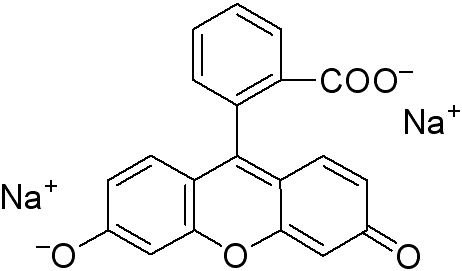All AbMole products are for research use only, cannot be used for human consumption.

Fluorescein Sodium is a phthalic indicator dye used as a diagnostic aid in corneal injuries and corneal trauma.

Exp Eye Res. 2024 Mar 27;242:109880.
Fibronectin binds integrin α5β1 to regulate macular neovascularization through the Wnt/β-catenin signaling pathway
Fluorescein Sodium purchased from AbMole

Exp Eye Res. 2023 Apr 18;231:109474.
Inhibition of AIF-1 alleviates laser-induced macular neovascularization by inhibiting endothelial cell proliferation via restrained p44/42 MAPK signaling pathway
Fluorescein Sodium purchased from AbMole

Patent. CN114524951B 2023-11-21.
Patent. CN114524951B
Fluorescein Sodium purchased from AbMole

Front Bioeng Biotechnol. 2022 Jun 1;10:913648.
Mussel-Inspired Microgel Encapsulated NLRP3 Inhibitor as a Synergistic Strategy Against Dry Ey
Fluorescein Sodium purchased from AbMole

SSRN. 2022 Apr.
Inhibition of TREM-1 Alleviates Choroidal Neovascularization in a Mouse Model
Fluorescein Sodium purchased from AbMole

Patent. CN114524951A 2022 May 24.
Patent. CN114524951A
Fluorescein Sodium purchased from AbMole
| Molecular Weight | 376.27 |
| Formula | C20H10Na2O5 |
| CAS Number | 518-47-8 |
| Solubility (25°C) | Water ≥ 100 mg/mL |
| Storage | RT, protect from light, dry, sealed |
| Related Fluorescent Dye Products |
|---|
| DSPE-Rhodamine
DSPE-Rhodamine is formed by the conjugation of DSPE with the Rhodamine fluorescent dye. DSPE possesses a hydrophobic lipid tail and a hydrophilic head group, while Rhodamine is a red fluorescent dye. DSPE-Rhodamine retains the lipid properties of DSPE while also imparting fluorescent labelling capabilities. As a key component of delivery systems, DSPE-Rhodamine enhances targeting and bioavailability. Its lipid properties facilitate the penetration of molecules through cell membranes, while its fluorescent properties enable tracking of distribution and dynamic changes within the body. |
| LD540
LD540 is a novel high-sensitivity lipophilic dye modified with BODIPY fluorescent groups, designed for precise labelling and imaging of lipid droplets. LD540 exhibits excellent photostability and an optimal fluorescence spectrum, making it compatible with various commonly used fluorescent dyes (such as DAPI and Alexa Fluor 647), thereby supporting multi-colour imaging requirements. Additionally, LD540 is suitable for both fixed and live cells and can label ultra-small lipid droplets. |
| PDMPO
PDMPO (Yellow/Blue DND-160) is a ratiometric probe for the determination of lysosomal pH for fluorescence imaging. PDMPO exhibits pH-dependent dual excitation and dual emission peaks. PDMPO produces blue fluorescence (Ex/Em=329 nm/440 nm) in weakly acidic organelles, and in more acidic lysosomes it becomes yellow fluorescence (Ex/Em=384 nm/540 nm). |
| Copper probe CF4
Copper probe CF4 (Copper fluor CF4) is a Cu+-specific fluorescent probe based on a rhodol dye scaffold. Copper probe CF4 (Copper fluor CF4) has high copper selectivity with a Kd value of 2.9×10-13 M, particularly over zinc and iron, as well as abundant cellular alkali and alkaline earth metals. Copper probe CF4 (Copper fluor CF4) is stable in a physiologically relevant pH regime between 6 and 8 (wavelengths of 415 nm for excitation and 660 nm for emission). Copper probe CF4 (Copper fluor CF4) can be used to study colon cancer. |
| Phalloidin-Fluor 647 Conjugate
Phalloidin-Fluor 647 Conjugate selectively binds to F-actins. Used at nanomolar concentrations, phalloidin derivatives are convenient probes for labeling, identifying and quantitating F-actins in formaldehyde-fixed and permeabilized tissue sections, cell cultures or cell-free experiments. |
All AbMole products are for research use only, cannot be used for human consumption or veterinary use. We do not provide products or services to individuals. Please comply with the intended use and do not use AbMole products for any other purpose.


Products are for research use only. Not for human use. We do not sell to patients.
© Copyright 2010-2024 AbMole BioScience. All Rights Reserved.
